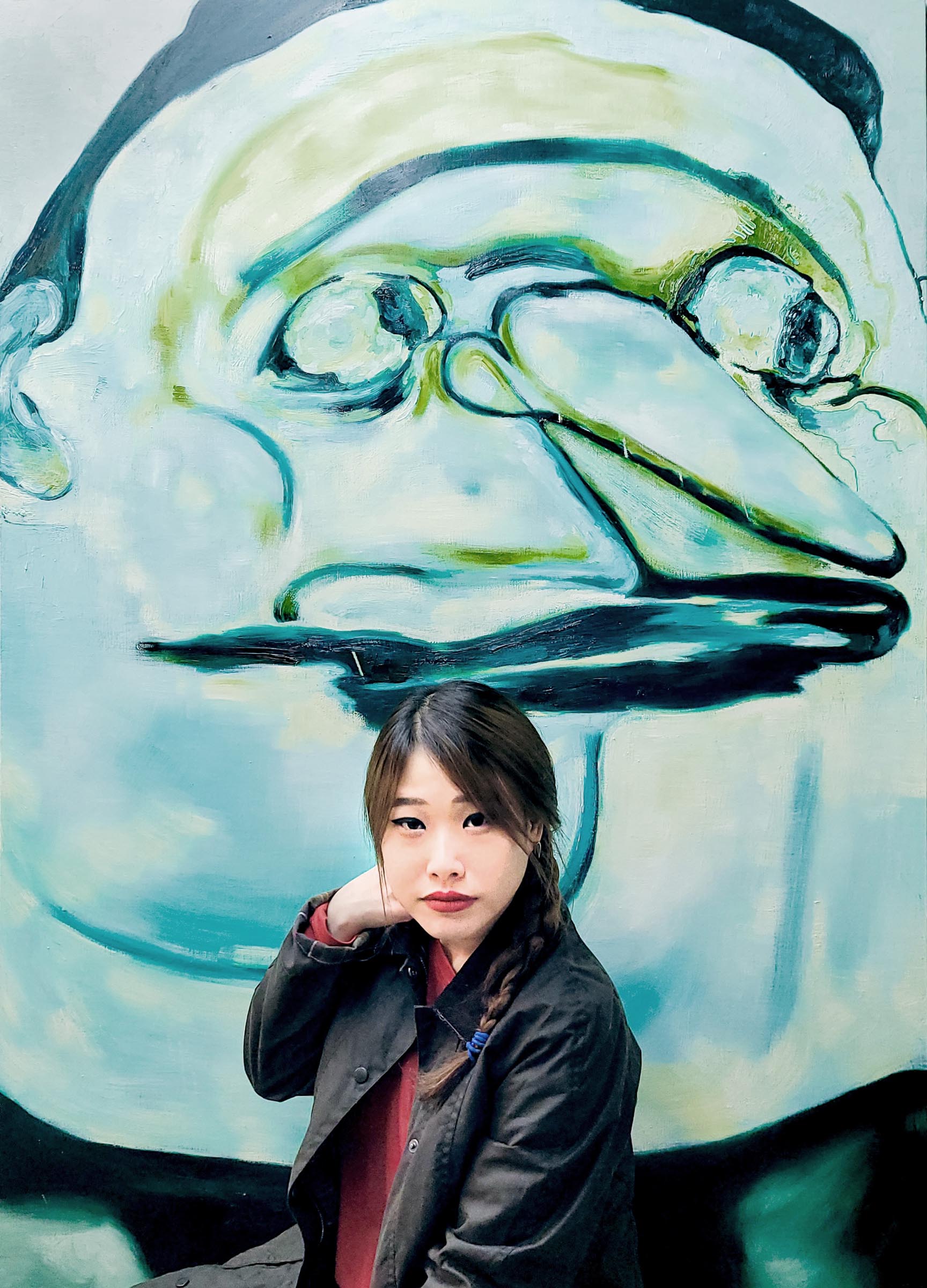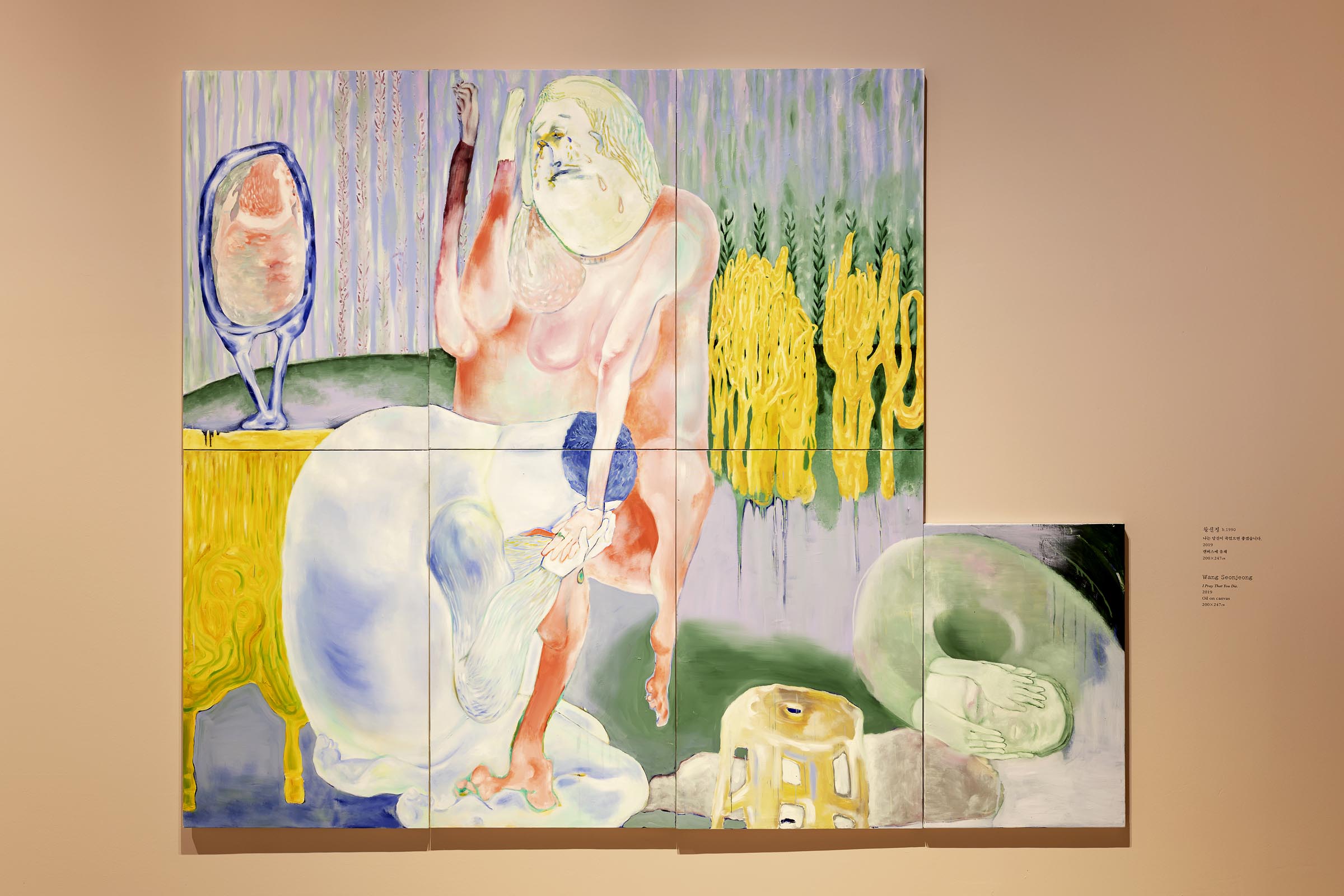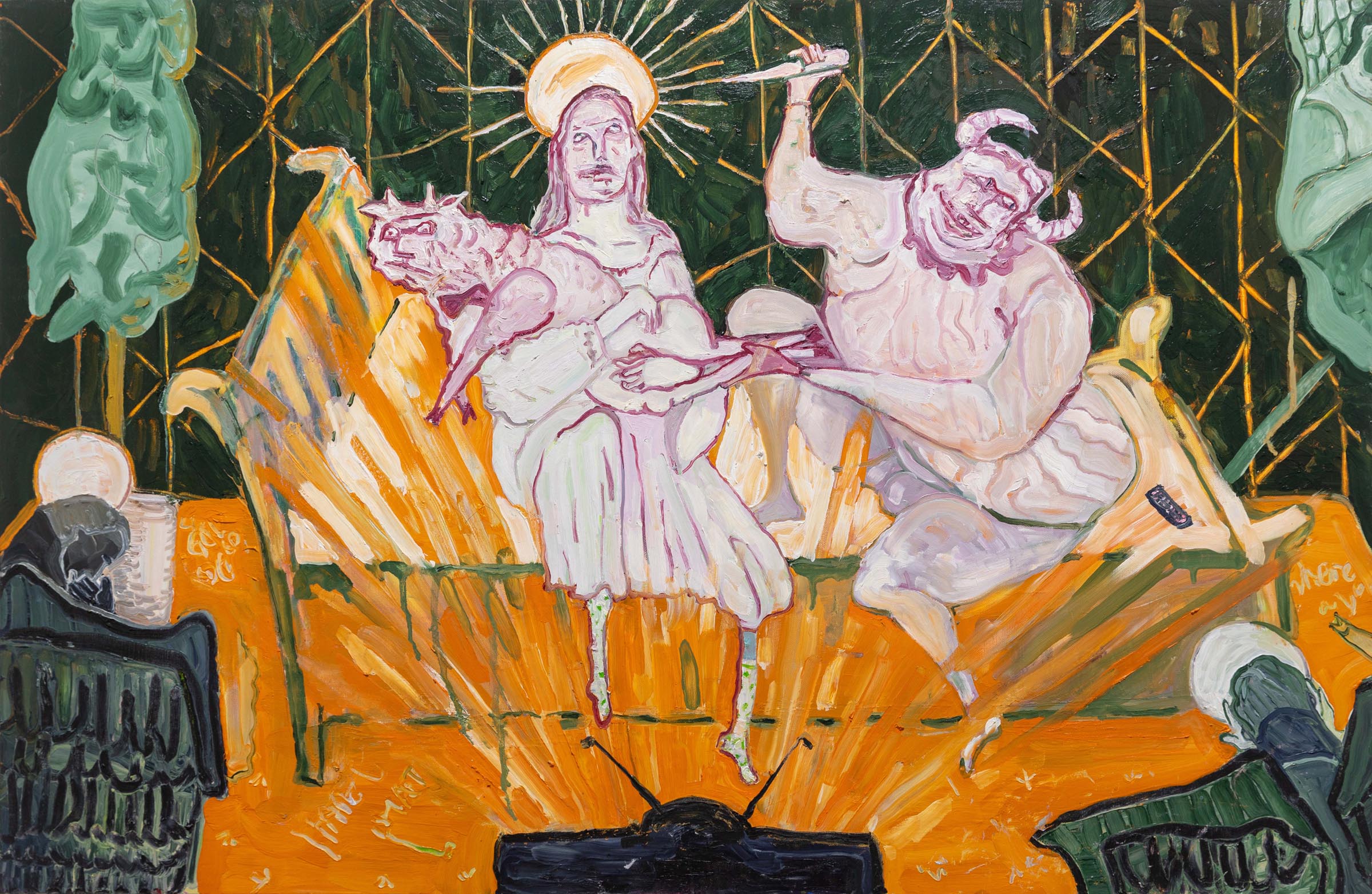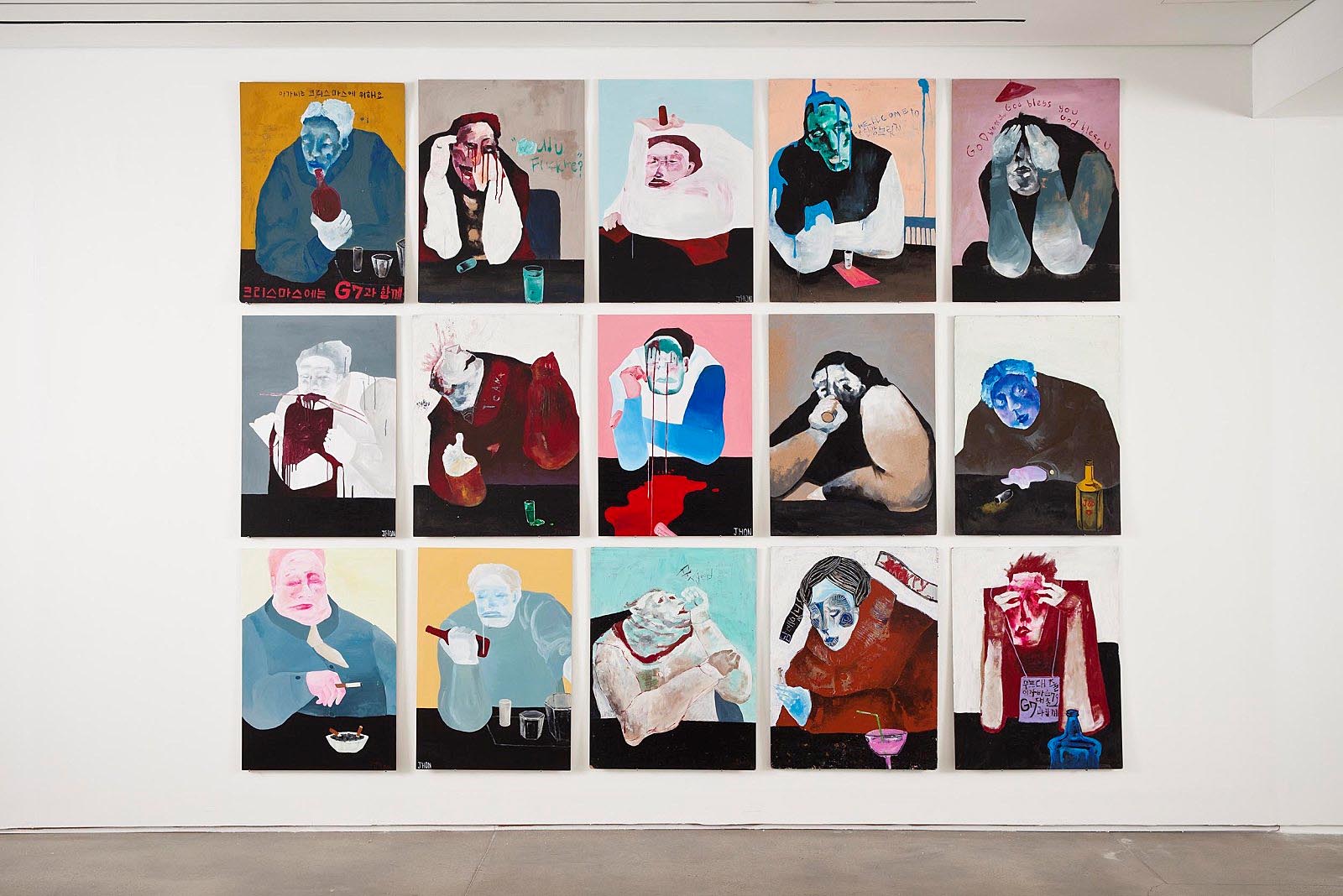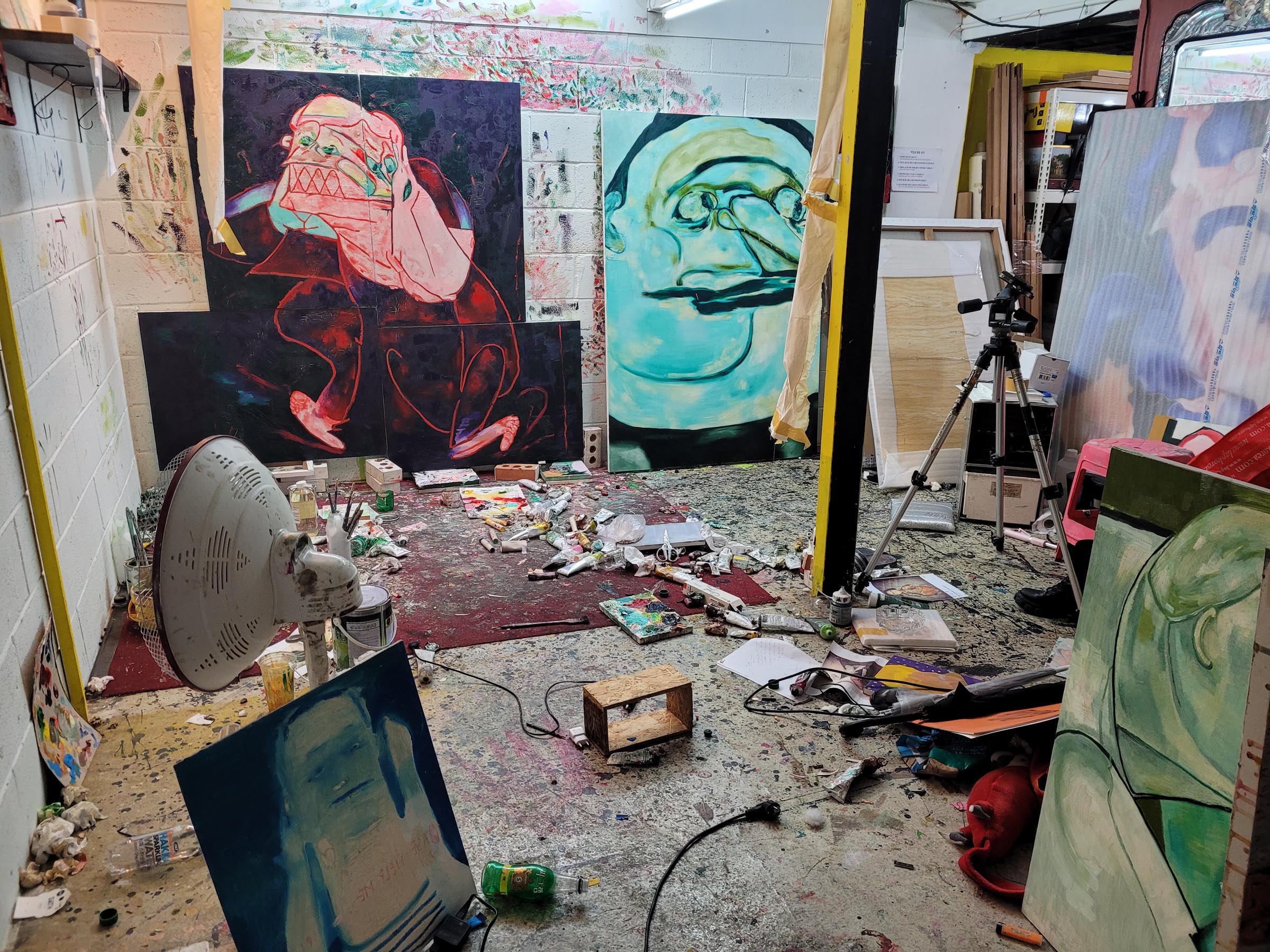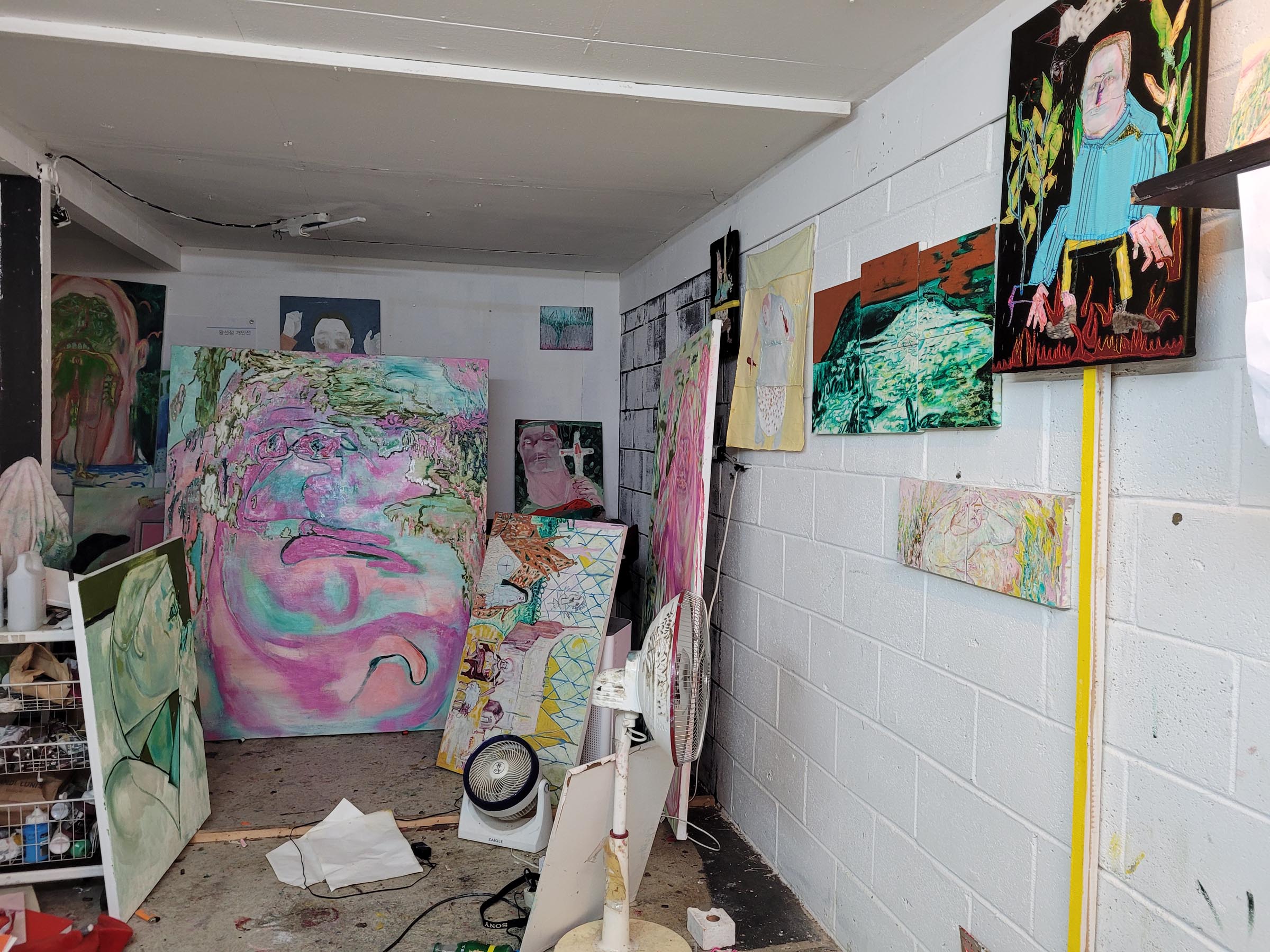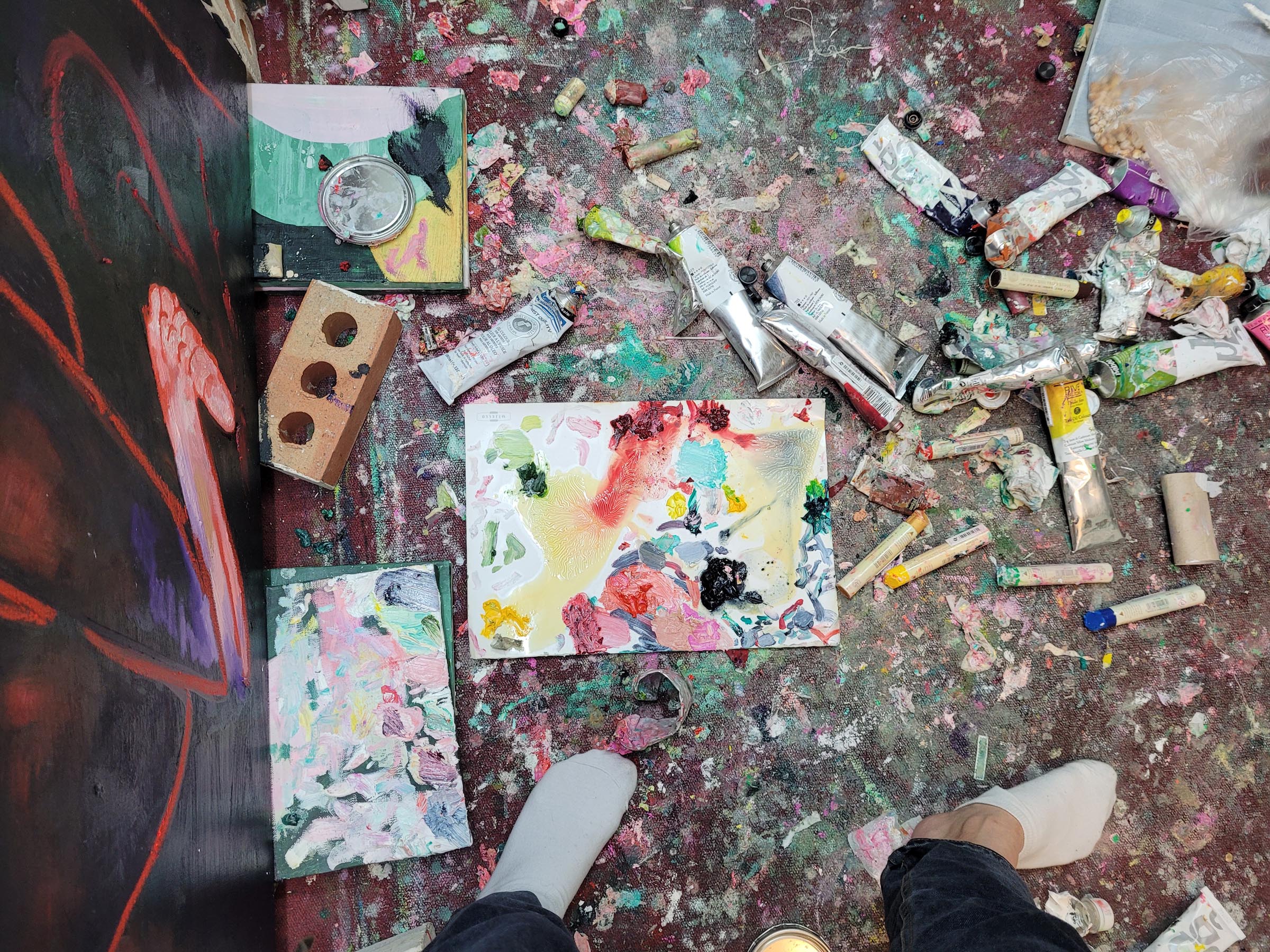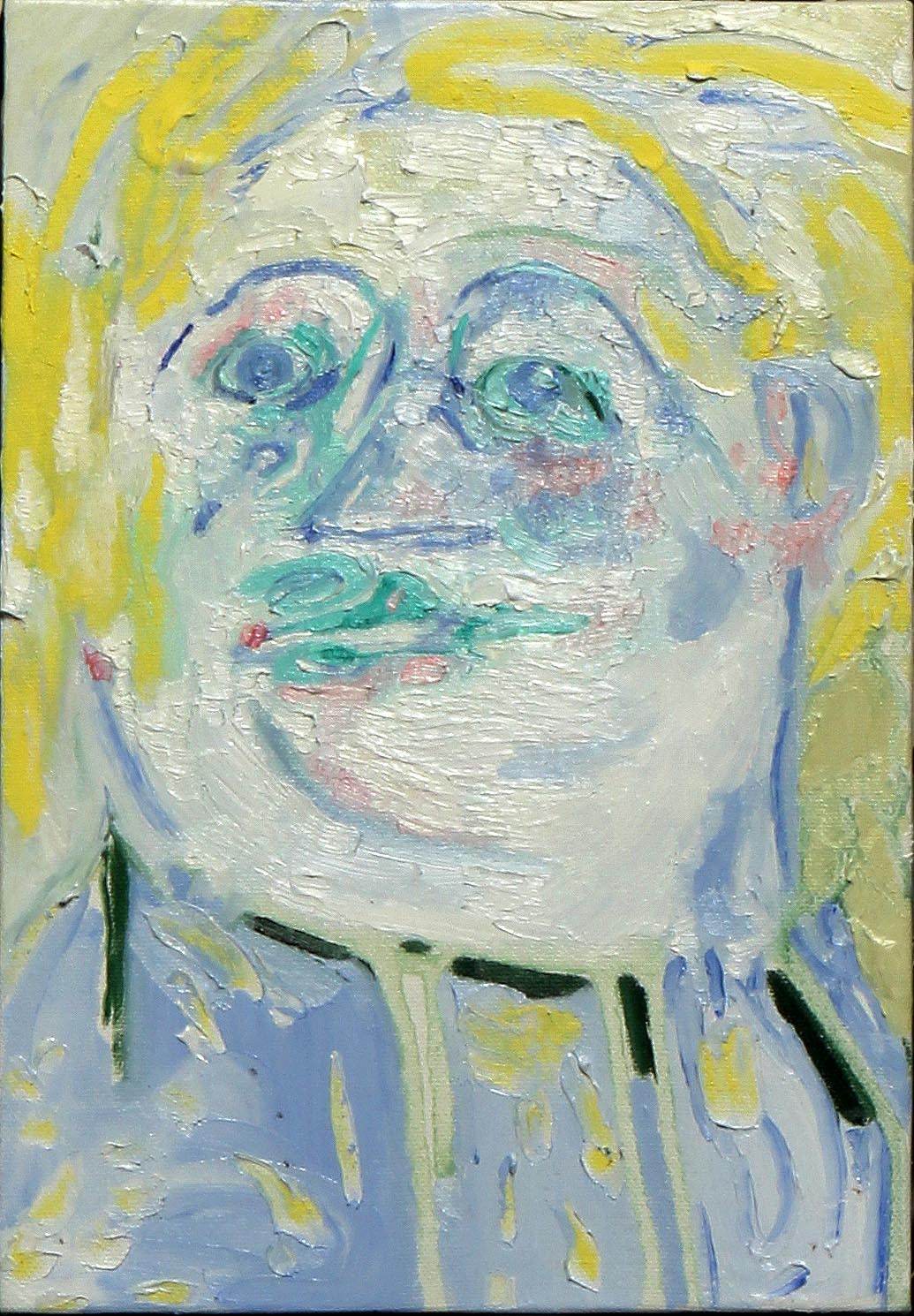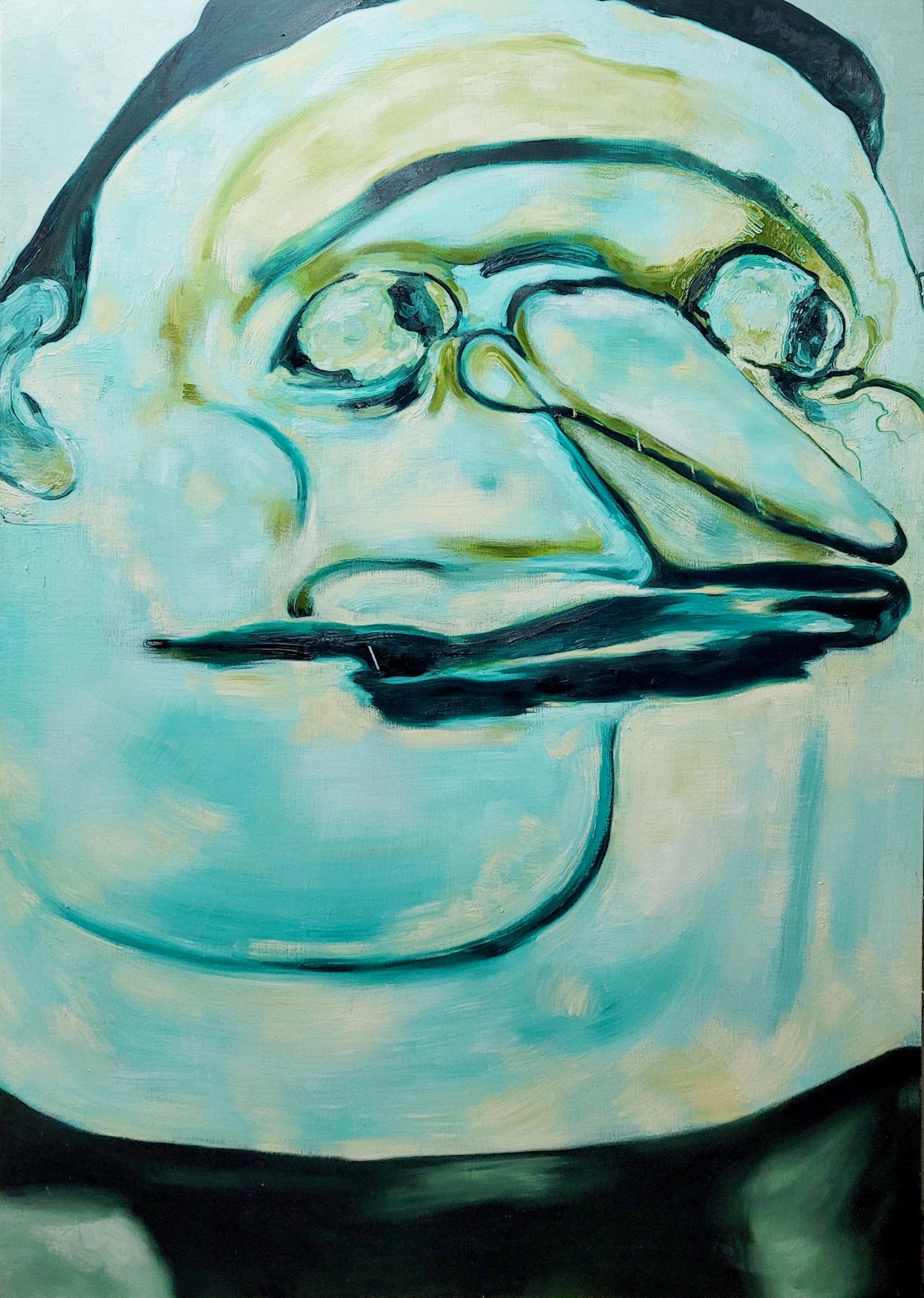How did you get into making art?
Since I was young, I played alone making dolls or sewing. And I drew pictures and constantly made something out of clay. I liked reading books and listening to music, but I was happiest when I made my own creation. And when I went to university and started working as an artist, I confirmed that painting was the only time I felt really alive. I think there is no motive in my life other than painting. Because the moment I complete the painting, I feel almost saved.
What are you currently working on?
The character in my painting is almost real, not imaginary. They’re the people I’ve been through or discovered and they’re all from reality. Those who are having an unfortunate love in hell shown in the painting I Pray That You Die_2019, is also a young sheep who Trying to escape from the loving but incompetent mother’s arms, as well as the perpetrator of violence in the painting series_ 2017~2018. Finally, all of the middle-aged men sitting on bars spewing alcohol out of despair in a series of series_2013 are like that. Most of the objects in my paintings are all crying. Suddenly I wanted to call my paintings ‘the beautiful scenery of a sad person’. /Someday we realize that even the beginning is in a routine of unhappiness where no cause can be found. Some people, of course, can try to solve big and small misfortunes, but that’s not possible for everyone. Ignorant denial of these ‘problems’ that even the cause is unknown may make us more truly unhappy. Rather than chasing the illusion of invisible ‘happiness’, what we need is a ‘positive attitude’ that embraces ‘the daily and absolute problems’, or ‘unhappy things’, and lives on its own. By affirming the misfortune like this, the tragedy is beautiful. We weren’t left behind in utopia, but there was a cloud in the sky that was actually nothing. In my previous text, ‘The Beautiful Landscape of a Sad Man’, what is beautiful is the ‘eye view’ of the unhappy world. He who embraces misfortune and affirms his distorted appearance is so beautiful. The place where you are in sorrow is a truly beautiful scene that I can draw. So I try to celebrate our misfortune or tragedy by drawing more brightly and beautifully.
What inspired you to get started on this body of work?
When I go to the studio and sit in front of an empty canvas, I think of ‘color’ either very intuitively or impulsively, depending on my feelings or senses triggered. The act of ‘remembering color’ is like the sensation or emotion that was wriggling and growing under the ground becomes ‘color’ and rises to the surface of the water. So starting to stir the brush over the canvas with colors that came up without any specific plan becomes the beginning of the work. And then I wait for one of the unspecific number of tragic characters who always live in me to rise among the stains of that color. The brush continues to brush until it finds the ‘eye’ of the character between the color and the traces of the lines where the brush has passed. I think this process is very accidental, but at the same time it is inevitable.
Do you work on distinct projects or do you take a broader approach to your practice?
1. I Pray That You Die, oil on canvas, 200 x 247 cm ,2019 The theme of the work is ‘Love in Hell’. I believe It is a love that can sustain life, in the unhappiness of Hellish reality and the ugliness of human bottom. I’m holding back on my value judgments Paying attention to the weakness inherent in nature, and expressing the weakness with delicate brush touch. It reveals the artist’s point of view the ugly is beautiful. In this painting, men and women hold each other and collapse in an overly colorful and patterned room. Everything in this space where are struggling with sorrow, this scene clearly shows the ambivalent aspects Of love and life. Perhaps it is where the love of hell coexists with splendor and humiliation, light and darkness, Pain and ecstasy, and these are the characters who live in the tragedy or comedy in this world. 2. ‘Ophelia 2 (2019)’, oil on canvas, 260 x 200 cm ,2019 In this painting, there is a life-threatening carnivore-like creature hiding in the water. This green presence, which is both colorful and protective at the same time, clearly illustrates the coexistence of the two opposite sides of life that I want to express. It’s probably the main character’s habit of living in the tragedy or comedy of this world, where splendor and vileness, brightness and darkness, pain and joy coexist together, like love in hell. 3. ‘Eden-Play’ series , 2017~2018 In the ‘Eden-Play’ series, the figures in the Bible appear on the canvas and play scene of everyday life, based on the artist’s experiences from my family in a male-dominated, authoritative, and conventional community of our society. In the Eden-play series, three major characters come out repeatedly. First, a male as the father or the devil runs around with a wicked and angry look. The my mother represented as Maria with a weak and sick face reveals the position of a passive woman in the family. Lastly, young sheep of the most powerless speak to not only the weakest found in any group, but also me and my older sister who had to live under the scary and violent circumstances caused by a patriarchal father. Ironically, I was born as Catholic from a devoted Christian family and raised with a Christian view of life, but disharmony between my catholic teachings and the insecure reality has led into her jocular and dramatic artworks. 4. Man in the bar- Baudelaire’s Revenants, 2013~2015 ‘ Baudelaire’s Revenants reflects the period when I used to work at a bar in Seoul, where I kept caricaturing numerous types of people I met everyday on a company ad notepad. The guests were mostly men dropping by after work, and they often let out their despair and anger while drinking. The feeling of misery that their behavior transmitted led me to translate those caricatures into the rough surface of the MDF painting as portraiture of our current conditions of life, where we internalize our common, daily agony. The depicted persons appear as like figures from Baudelaire’s poetry; fallen, isolated and narcissistic. 5. A Watery lily, 28 x 19 cm, OIL ON CANVAS,2020 The title refers to ‘a watery lily’ or ‘a water-flowing lily’. The woman in the picture is scattered as if in a dim mist. Yellow blue green lines and stains become hairstyles, eyebrows, and eyes. Looking sad and exhausted, the woman’s blue eyes are looking exactly at something in front of them. She is looking at us and at the same time, the person who looks at the picture also looks at her. To be watching is to know. In fact, the most important things in the world are invisible. Whether she or we know there are certain things that we trust and wait for. The woman is likely to scatter, but with clear eyes, she is clearly waiting for something to come. 6. A Amanita muscaria (a poisonous mushroom that looks like a clown), 28 x 19 cm, OIL ON CANVAS,2020 Toxic animals or plants have hallucinogenic patterns or colors. Poison or colorful patterns are a warning to predators, but they are essentially a means to protect themselves from predators. Therefore, the colorful rainbow colors suggest a fragile life to survive. The figure in this painting is ‘spouting’ rainbow-colored tears. The eyes of the hot pinkish figure are divided, but his dark green eyes are still alive.
What’s a typical day like in your studio?
I go to work four days a week for a living. This job is not related to art or my major, and I am in charge of office assistance. Instead, I go to the studio and draw pictures for three days when I don’t come to work during the week. As soon as I wake up, I go to a studio near my house, where I eat coffee and peanuts, smoke cigarettes, and then sit on the floor of my studio and start painting. My studio is very dirty, but I feel the most cozy there. I usually work with very loud and strong beat music or depressed and sensual music on. And when I feel dizzy because I’m out of energy, I go back home.
Who are your favorite artists?
Among the painters of the past, I like ‘Edvard Munch’ and ‘Claude Monet.’ Among contemporary artists, they like ‘Robert Combas’ , ‘David Hockney’ and ‘Marlene Dumas’.
Where do you go to discover new artists?
Past painters search for contemporary artists through Googleing and Instagram searches. In fact, when I was in school, I liked to go to the library and see a collection of paintings, but it is not easy to access them after graduation.
